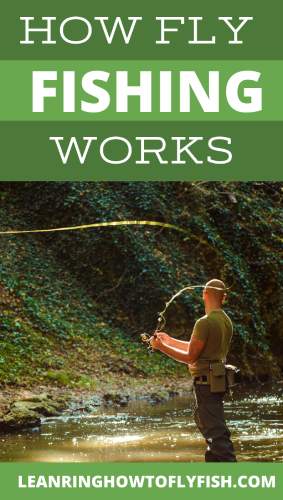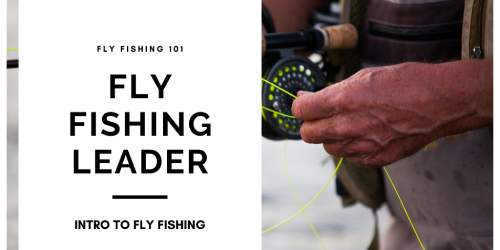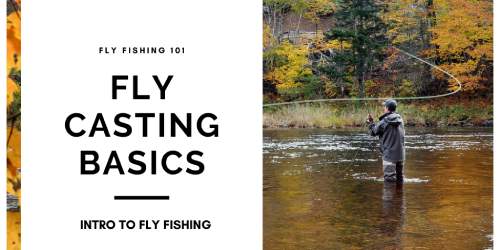How Does Fly Fishing Work – How to Cast and Catch Fish
8 Minute read 📖 We do not use AI to create content; written by Anglers, for Anglers 🎣

Have you ever wanted to to try fly fishing but your not really sure how it works?
Well, you’ve landed in the right spot! In this article we’ll break down exactly how fly fishing works to get you on the right track.
Fly Fishing has a very rich history as it has been around in some form or another since hunter gatherer times. It has evolved from a simple survival skill to a recreational sport.
There are a few basic components and concepts that are fundamental to your fishing success. Lets get started and cover some basic information so that you can move one step closer to catching fish.
Components Of A Fly Cast
There are a few pieces of vital gear that you must have in order to fly fish.
- Fly Fishing Rod
- Fly Fishing Reel
- Line
- Fly Fishing Leader
- Fishing Flies
It is not uncommon for fisherman to not choose the right fly rod to get started fly fishing. You do not need a fancy $1000 fly fishing rod to be successful. I have used my $200 combo for many years and have caught hundreds if not thousands of fish with it.
If you buy a combo fly fishing rod, it will often times be spooled with fly line already. If not, you will have to spool the fly line yourself.
You will need to add your fly leader and fishing flies yourself. Sometimes they are sold as part of a beginner starter pack or similar. These are fine for starting out but you will eventually have to buy some more leader and tippet.
Recommended Article 👉 How to Choose A Fly Rod
So, How Does Fly Fishing Work?
Fly fishing is not a complicated activity (in theory)!
Simply put, Fly Fishing is the ability to use a fly rod, fishing reel, and artificial flies to catch fish.
Using this equipment, you still must present your fly to the fish! This part is easier said than done. Casting a fly is where the art form of the sport really comes into play. 🎨
How to Cast A Fishing Fly 🤔

When first learning how fly fishing works, you should stick to a basic fly cast.
A basic fly cast involves a backward motion of your fly rod, followed by a forward motion, and repeated until you have achieved the desired distance landing the fly in your target location.
This is obviously over simplified for the sake of this article, & only refers to the basic concepts. See our other articles on fly casting if you wish to learn more.
The motion of the back cast creates energy that is transferred from your arm to the fly. 🎣
As you put your arm in motion the fly rod will go into motion as well. At this point energy is being transferred into the rod.
The energy moves through the fly rod until it reaches the tip of the rod. At this point the energy starts transferring into the fly line putting the fly fishing line into motion.
At this point the energy transfer continues down to the fly.
This process is repeated until you wish for your fly to touch or enter the water. Once your fly is presented to the fish, your job is not finished, but your cast is.
There are many other types of fly casting; no one cast is ideal for every situation. Often times we are fishing in windy conditions, steep terrain, need to make shorter or longer casts, fishing in heavy current, or from a boat. This situations may require another type of fly cast.
Recommended Article 👉 What is A Fishing Fly and How to Select the Right One
Setting The Hook 🪝
Once you have selected the perfect fly and introduced your fly to the water, only half of the work is done. Now you must patiently await a strike, watching your fly or your fly line.
Once the strike occurs, its time to set the hook! Depending on species of fish, you will need to apply more or less power to setting your hook.
Species like Trout and Panfish have a soft mouth, & therefore less pressure is needed. Other fish like bass, pike, or saltwater fish will require more pressure.
The process of setting the hook will look something like this.
- Hold the rod in your dominant hand.
- Pinch the fly line in your hauling hand (the other hand).
- Take note as to how slack in your fly line. Whenever possible reduce slack in the line.
- When you see the take, pinch the fly line with your hauling hand tightly.
- Simultaneously, raid your fly rod pointing the tip to between the 9 or 12 o’clock position (depending on slack).
If you are successful, the fight is now on!
If you miss the fish, do not get down on yourself. This is a fairly common occurrence in fly fishing. There can be multiple factors in missing a strike. That will be another article for another day.
There’s just one more step if learning how fly fishing works, the fight!
Fighting the Fish 🐟
If you are successful with both your cast, and again successful with setting the hook, the third phase is the fight.
When fighting your fish, it is important to follow these key tips in order to land it.
- Keep slack out of your line
- Do NOT horse the fish or think that you have to get them in quickly.
- Don’t keep your rod at maximum height. You will have to motion to reduce slack if the fish swims at you.
- If you have a decent amount of line out try and get the fish on the reel. Reel in the slack while maintaining tension.
- Raise the rod to bring the fish toward you small sections at a time.
- Slowly lower the rod tip while reeling in the slack.
- Lead your fish with the rod tip in opposing direction. It the fish runs left, move the rod tip laterally to the right.
- Repeat these steps until the fish is a little more than a rod length away form you.
- Pinch your line into your rod hand and grab for your net.
- Raise your fly rod tip while reaching out with your net. Don’t stab at the fish while landing your catch.
Recommended Article >> How To Spool A Fly Reel -Step By Step Guide.
Handling Your Fish 🫴

This is one of those areas in fly fishing that you will hear anglers bicker about all day long. You can do your own research into what is or is not harmful to your catch. Each species may be slightly different.
There are some unmistakable tips to not injury the fish however.
- Use a net
- Keep the fish wet
- Keep fingers out of the gill area
- Don’t over handle
- Allow the fish to recuperate before release
- Use forceps to reduce handling
It is important to preserve these creatures in our fisheries.
It is our responsibility as anglers to maintain the ecosystems and also the reputation of the sport. If the anglers of today abuse their fish, it will hurt the anglers of tomorrow.
Fly Fishing – Final Thoughts 🏁
The information here simply scratches the surface on Fly Fishing.
Fly fishing takes time to master, it can’t all be learned in one day or one trip. Try heading into your local fly shop and asking the folks there some questions. I have found that they are more the happy to teach you a thing or two. If your able to support local fly shops I highly recommend that as well.
I hope you can use some of these tips the next time your out on the water. Let me know if you have any good tips for beginners in the comments below.
Good luck out there!



